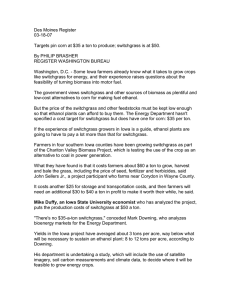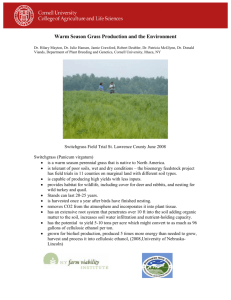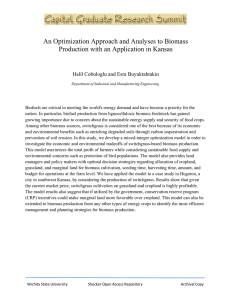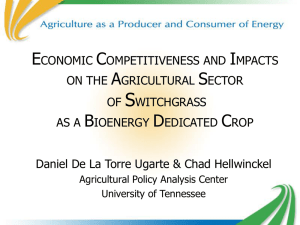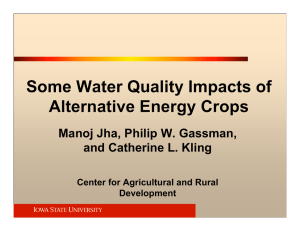Switchgrass for Biomass Energy Rob Mitchell USDA-ARS Grain, Forage, and Bioenergy Research Unit
advertisement
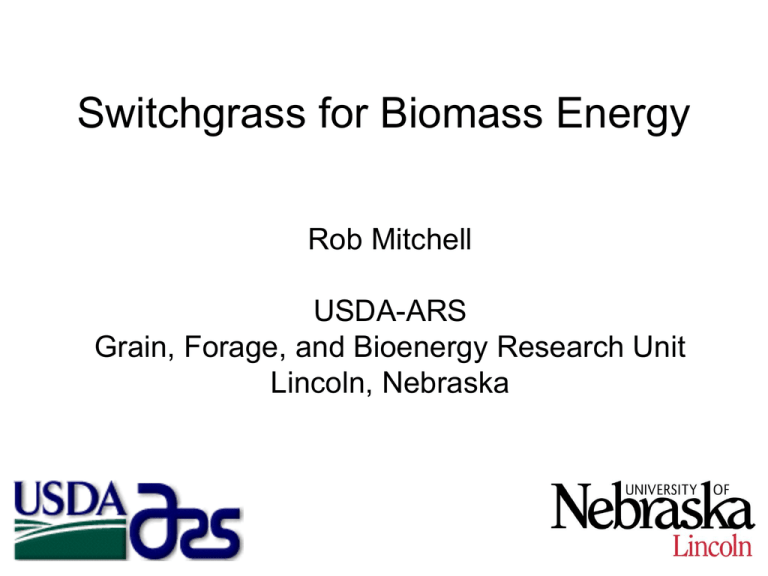
Switchgrass for Biomass Energy Rob Mitchell USDA-ARS Grain, Forage, and Bioenergy Research Unit Lincoln, Nebraska Where are We Going? Background Establishment Production, Harvest and Storage Switchgrass Production Economics Switchgrass Energy Production Land Requirements and Feedstocks Answer Biorefinery Questions Native to Tallgrass Prairie Ecologically functions as a monoculture Switchgrass Biomass Energy Current Goals & Research Goals • Full establishment in 1 year with 50% yield • Be at full production (5 t/a) second year • Goal of 10 t/a in Midwest; increase ethanol yield/ton • Fully document environmental benefits Tools and Products • Weed control, no-till planting, seed quality • Breeding - Biomass specific cultivars & F1 hybrids, improved conversion, NIRS • Molecular biology, cell walls, conversion & seed quality • C sequestration, entomology Establishing Switchgrass How do you get from this… …to this? Switchgrass Establishment Recipe •Is switchgrass feasible for the area? •Suitable for dryland corn = suitable for switchgrass •Plant 2 to 3 weeks either side of optimum corn planting date •Develop a good seedbed •No-till seed into soybean stubble •Clean till and pack to leave a faint footprint •Use high quality certified seed of adapted material •Plant at least 30 PLS per ft2 ¼ to 1/2” deep •Manage weeds ASAP! •Pre-emergent application of 1 qt. of atrazine plus 8 oz of quinclorac/acre •Mow or spray broadleaves with 1-2 qt./a of 2,4-D in summer •Spend money on quality seed & weed control Switchgrass seedling morphology, seedbed firmness, and planting depth Seedlings develop adventitious roots at soil surface not at seed. Soft seedbed with packer wheel depression Planting depth Seed Seed < 1/2” deep . } = 1/2” } = 1/2” First rain fills the depression Seed . } = 1” The seed is too deep and will have problems emerging Worst-Case Scenario for Switchgrass Establishment 5 May 2006 6 October 2006 2.5 tons/acre •No-till seeded 57 acres into soybean stubble on 5 May 2006 •Pre-emergent application of 1 qt. of atrazine plus 8 oz of quinclorac/acre •Received 5 in of rain for the first 90-days after planting (40% of LTA) •Mowed & sprayed with 2 qt./acre of 2,4-D to control broadleaf weeds in July •Produced 2.5 tons/acre near Mead, NE in the establishment year (50% of our yield goal) •Seed quality & weed control are critical to economical switchgrass production Worst-Case Scenario for Switchgrass Establishment 31 July 2007 4 tons/acre 27 September 2007 4 tons/acre 2 tons/acre regrowth Worst-Case Scenario for Switchgrass Establishment 7 August 2008 6 tons/acre 17 October 2008 5-6 tons/acre ~1 ton/acre regrowth Averaged over 4 tons/acre for the planting year and the first 2 production years Switchgrass Harvest & Storage Switchgrass Harvest & Storage Switchgrass Harvest & Storage 24% DM loss in 12 months Big squares rapidly degrade outside 3 or 4 wraps reduces spoilage Chopping reduces density Major Questions for Perennial Herbaceous Bioenergy Crops 1. Can perennial herbaceous biomass energy crops be produced at a cost which makes their use for biomass energy economically feasible? (Initial goal was to compete with $35/barrel oil.) 2. Are perennial biomass energy crops net energy positive? 3. New Question: Are they greenhouse gas neutral or negative? Northern Plains Field Scale Production and Economics Trial 15”-17” Annual Precipitation 2000-2005 On-Farm Production Trials: 15-20 acre (6-9 ha) fields Cooperating farmers paid to manage fields as biomass energy crops. 31”-33” Annual Precipitation USDA switchgrass study 10 locations for 5 years 165 acres seeded Seeded with commercial drills Dryland sites Harvested entire field with commercial hay equipment Switchgrass Average Annual Production Costs Cost Item $/Acre $/Ton Planting 12.74 5.74 Herbicide Applied 12.95 5.84 Fertilizer Applied 15.04 6.78 Harvest 32.65 14.72 Total Operating Costs 73.38 33.08 Land Rent 59.70 26.91 Total Cost 133.08 59.99 Costs are annualized at 10%. Perrin et al. 2008 Previous Switchgrass Producer vs. New Crop Producer Five Year Average Cumulative Costs Experienced (2) New crop producer (8) Total costs Costs (no land $) $/ton $/ton $43.13 $26.42 $69.16 $37.28 Experience helped producers reduce production costs by $10.86/ton during the 5 production years. Perrin et al. 2008 Extension Efforts Will Pay Dividends Field of Jerry Roitsch near Bristol, South Dakota •5-year average yield of 4.2 tons/acre •Average cost of $38/t including land & labor •Farm gate feedstock cost was $0.48/gal •Based on 80 gallons of ethanol per ton, each big bale equals 50 gallons of ethanol Paramount Herbicide vs. No Paramount in Establishment Year Five Year Average Cumulative Costs Paramount used (4) No Paramount (6) Total costs $/ton $44.06 Costs (no land $) $/ton $28.35 $77.22 $39.62 Applying Paramount in the establishment year reduced production costs by $11.27/ton for 5 production years, a $124/a return on a $20/a investment. Perrin et al. 2008 Year 1 Harvests vs. No Year 1 Harvest Comparisons Five Year Average Cumulative Costs Year 1 Harvest (3) No Year 1 Harvest (7) Total costs $/ton $44.22 Costs (no land $) $/ton $27.61 $72.41 $38.32 Harvestable yields in the establishment year reduced production costs by $10.71/ton over the 5 production years. Perrin et al. 2008 On-farm Switchgrass Production in the Great Plains – Energy • Previous models over-estimated the energy inputs for switchgrass production by as much as 2X • Switchgrass produced 13X more energy as ethanol than was required as energy from petroleum • Switchgrass produced 540% more renewable than non-renewable energy consumed on marginal land when properly managed • Switchgrass biofuel production systems are economically feasible, and energetically positive on marginal cropland in the central USA east of the 100th Meridian Schmer et al. 2008 – Proceedings of the National Academy of Science USDA switchgrass study 10 locations 67 ha seeded Seeded with commercial drills Man-made prairies Dryland sites One location Harvested entire field with commercial hay equipment Small-plots Hand-seeded Irrigated during establishment Hand-weeded Hand-harvested - 10cm wide strips Managed switchgrass produced 97% more ethanol yield than man-made prairies Ethanol Yield (L ha -1) 4000 USDA study Low yielding farms Mean yield High yielding farms 3000 Tilman et al., 2006 2000 1000 0 Switchgrass (Field-scale) LIHD LI-SW Corn grain (NGP) What about soil carbon? Switchgrass grown for bioenergy: Soil carbon storage in 5 years: 0-30 cm Switchgrass Soil Carbon Sequestration when grown and managed as a biomass energy crop Field near Douglas, Nebraska • C storage for field at left: - 1 Mg SOC/ha/y in the top 30 cm of soil - 3.7 Mg SOC/ha/y in the top 120 cm of soil Liebig et al. 2008 (in press) Grass to crops – what happens to the soil carbon? • • • • Searchinger et al, Science 2008 – sequestered carbon from perennial bioenergy crops is lost due to plowing and crop production. Fact: plowing is not necessary and not recommended. Too expensive and sod-seeding is easier. What happens to sequestered C under no-till farming? Soybeans in big bluestem sod Soybeans Soybeans in indiangrass in fescue sod and bluegrass sod Mitchell et al., 2005. Renovating pastures with glyphosate tolerant soybeans. Online. Forage and Grazinglands doi:10.1094/FG-20050428-01-BR. Change in soil C – bromegrass sod to no-till corn: 10-30 cm for 6 years. Mead, NE Data from R. Follett et al., in review. Switchgrass for Bioenergy Economics and Environmental Issues • Switchgrass grown for biomass energy is net energy positive • Evidence is accumulating that indicates switchgrass is greenhouse gas neutral or negative (that is good!) • Switchgrass has wildlife & other benefits • Switchgrass fits the landscape and can be profitable Long-term Study of Corn & Switchgrass Mead, NE • 10-year experiment established in 1998 on marginal site in eastern NE • In 2000, corn plots were split & 50% of stover removed on half of plots • Evaluate PV & no-till corn on marginal sites for: – Corn stover removal effects on yield – Response to applied N – Ethanol Production – C sequestration – Switchgrass competition – Sustainability of PV harvest & corn stover removal Effect of 50% stover removal on corn grain yields in eastern NE fertilized with 120 kg N/ha. Mean Yields in kg/ha for first 5 years. 12.0 Figure 2. Yield (Mg/ha) 10.0 8.0 6.0 4.0 2.0 0.0 H1 H2 Grain H1 H2 Stover Varvel et al. 2008 Biomass & Bioenergy. H1 H2 Total Removing ½ of stover reduced grain yield by 7.2% Grain Biomass (Mg/ha) 25 20 15 Corn Grain after removal ½ stover removed Corn Grain - 7.2% grain 10 5 0 2000 2001 2002 2003 2004 2005 2006 2007 Mean Removing ½ of stover reduced biomass yield by 5% Total Biomass (Mg/ha) 25 20 15 Corn (Grain + Stover) after removal ½ stover removed Corn (Grain + Stover) - 5% biomass 10 5 0 2000 2001 2002 2003 2004 2005 2006 2007 Mean Switchgrass Harvested Post Frost was Greater than August August Post Frost Biomass (Mg/ha) 16 14 12 10 8 * * * * 6 4 2 0 1998 1999 2000 2001 2002 2003 2004 2005 2006 2007 Mean Switchgrass Biomass Increased as N Increased Biomass (Mg/ha) 0 60 120 18 16 14 12 10 8 6 4 2 0 1998 1999 2000 2001 2002 2003 2004 2005 2006 2007 Mean Corn Biomass was Greater than Switchgrass in August Biomass (Mg/ha) 20 15 Switchgrass ½ stover removed Corn (Grain + Stover) 10 5 0 2000 2001 2002 2003 2004 2005 2006 2007 Mean Corn Biomass was Similar to Switchgrass Post Frost Biomass (Mg/ha) 20 15 Switchgrass ½ stover removed Corn (Grain + Stover) 10 5 0 2000 2001 2002 2003 2004 2005 2006 2007 Mean Seeding year In an 84-month period, 62 months (74%) were in drought When Should Switchgrass be Harvested? Biomass (Mg/ha) 16 14 Linear (August) 12 10 y = 0.0917x - 175.57 R2 = 0.075 8 6 4 y = -0.4893x + 986.27 R2 = 0.57 2 0 1999 Biomass (Mg/ha) Linear (Post Frost) 2000 2001 2002 2003 2004 2005 2006 18 17 16 15 14 13 12 11 10 2007 2008 Switchgrass biomass curve developed from first growth ‘Cave-in-Rock’ switchgrass harvested at 7-day intervals from 5 production environments in August, September, October, and November in 2004, 2005, 2006, and 2007 at Mead, NE. 200 225 250 275 Day of Year 300 325 Where Are We Going? Conventional Breeding Progress Yield Trial Mead, NE 2003-2005 Cultivar Year released 1984 Biomass yield -Ton/a (Mg/ha) 6.3 (14.1) IVDMD (%) (mature) 52.5 Trailblazer Shawnee 1995 6.5 (14.5) 54.8 7.4 (16.6) 53.8 7.0 (15.7) 55.2 NE 2000C1 In seed increase NE Late In seed YD C4 increase Hybrid Switchgrass Strain Kanlow & Summer F1’s Kanlow Summer Yield Tons/A (Mg/ha) 9.4 (21) 7.1 (16) 6.1 (14) Vogel & Mitchell, Crop Sci. 2008, In press. • Improved hybrid cultivars with modified cell walls could improve ethanol yields & reduce costs. High-input low-diversity polycultures, currently-available switchgrass, and hybrid switchgrass are feasible feedstocks Mixture Yield T/A (Mg/ha) SN40, PV20, BC40 6.9 (15.5) AG40, SN20, BC40 6.7 (15.1) AG20, SN60, PV20 6.7 (15.1) AG40, SN40, PV20 Forage-type Switchgrass Hybrid Switchgrass 6.7 (15.1) 5.1 (11.4) 9.4 (21.2) Biorefinery Investor Questions 1. How soon can switchgrass be supplied to the biorefinery? 2. Can adequate biomass be produced and delivered to the biorefinery in a timely manner? 3. Is production system information available, verified and sustainable? 4. Bottom Line: Can the area provide a reliable & affordable feedstock supply for the longterm? Question 1 How soon can switchgrass be supplied to the biorefinery? Answer: Full scale switchgrass production could occur in as little as 5 years. Large-scale switchgrass production will require a 2-year lead time before initiating biorefinery construction, assuming Foundation Seed is available for planting Certified Seed fields. Year 1 Year 2 Year 3 Year 4 Year 5 Harvest Foundation Seed 500-1000 # PLS/a 500-1000 # PLS/a 500-1000 # PLS/a 500-1000 # PLS/a 500-1000 # PLS/a Plant Certified Seed - 2 # PLS/acre Harvest Certified Seed - - 500-1000 # PLS/a 500-1000 # PLS/a 500-1000 # PLS/a Plant Biomass Fields - - - 4 # PLS/acre Harvest Biomass Fields - - - 2 tons/acre 4 tons/acre Biorefinery - - Begin Construction Finish Construction Full Production Question 2 Can adequate biomass be produced and delivered to the biorefinery in a timely manner? Answer: Using the above seed production timeline, adequate biomass can be produced and delivered to the biorefinery in as little as 5 years. Potential dry matter (DM) yield for herbaceous perennial feedstocks in the Great Plains and Midwest. A 50-million gallon cellulosic ethanol plant will require 625,000 tons of feedstock per year, assuming 80 gallons of ethanol are produced per DM ton. Yield, DM tons/acre Acres needed to grow 625,000 DM tons/year Percent of land in 25-mile radius 1.75 357,000 28 5 125,000 10 150 bu/acre 111,111 8.8 Bioenergy switchgrass3 7.4 84,460 6.6 Hybrid switchgrass4 9.4 66,489 5.3 Feedstock LIHD1 Shawnee switchgrass2 Corn 1Low-input, high-diversity mixtures (Tilman et al. 2006). forage-type switchgrass cultivar released in 1995. 3Lowland Bioenergy-specific switchgrass in the cultivar release process. 4F1 hybrid of Summer and Kanlow switchgrass cultivars that will likely reach field-scale production in 10 years (Vogel and Mitchell 2008). 2Upland Question 3 Is production system information available, verified and sustainable? Answer: Switchgrass has been grown and managed since the 1930’s. Based on more than 70 years of research, switchgrass production is feasible, verified, and sustainable. Question 4 Can the area provide a reliable & affordable feedstock supply for the long-term? Answer: Switchgrass can provide a reliable and affordable feedstock supply for many areas in the Central and Northern Great Plains, but the preferred feedstock will vary by locations within agro-ecoregions. Where will Cellulosic Ethanol Plants Fit? A 50-million gallon Ethanol Plant Will Require: 125,000 acres of switchgrass assuming 5 tons/acre and 80 gallons of ethanol/ton of switchgrass. The Upper Big Blue NRD has 1.83 million acres, 1 million irrigated acres, and 4,600 center pivots. This NRD could grow 128,800 acres of switchgrass in pivot corners alone. Has 4 existing corn ethanol plants and others under construction or in various planning stages. 25-mile radius Conclusions • There is no one-size-fits-all bioenergy system. • Based on nearly 20 years of bioenergy research, we can grow switchgrass in the central USA and be near 50% full production 5 months after seeding and near full production 15 months after seeding. • Switchgrass will not displace corn on prime cropland. • Switchgrass is productive on marginal land when properly managed. Conclusions • Switchgrass biofuel production systems are economically feasible on marginal cropland in the central USA east of the 100th Meridian. • Properly managed switchgrass and warmseason grass mixtures will provide adequate feedstock supply for efficient transport. • The green revolution was successful because of improved genetics and agronomics. Production of sustainable green energy will likewise depend on improved genetics and agronomics. Questions? Transportation Fuel Cost ($/gallon) Feedstock Refining & Profit 3.50 $3.29 3.00 0.49 2.50 2.00 0.56 Taxes $3.02 0.49 0.33 $2.13 0.66 0.49 1.50 1.00 Distribution & Marketing 1.91 0.50 0.33 $1.29 1.12 0.56 0.19 0.13 0.22 0.75 0.75 0.75 0.00 Gasoline Cellulosic Cellulosic Cellulosic Ethanol (Same $ Ethanol (Same % Ethanol (Same costs as gas) costs as gas) tax + 2x D&M + 2x Refining & Profit) U.S. Average Regular Pump Price in 2008 was $3.29/gallon www.eia.doe.gov/steo
